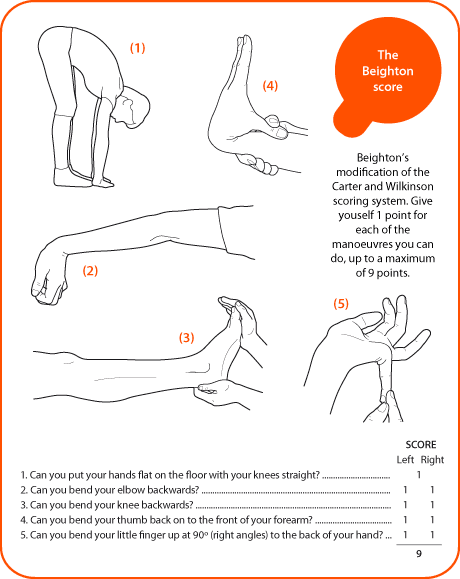Joint hypermobility managed with Orthoses
A more-than-normal range of movement (ROM) in a joint.
Joint hypermobility can be localized to a specific joint, or generalized throughout the joints of the body. When generalized, hypermobility may occur with symptoms such as muscle or joint pain. Joint Hypermobility Syndrome (JHS) and Ehlers Danlos Syndrome (EDS) are severe connective tissue disorders that affect the entire body and have overlapping symptoms. EDS is an inherited connective tissue disorder characterized by abnormal collagen synthesis. Symptoms may include severe joint hypermobility, skin laxity, and tissue fragility accompanied by pain and recurrent joint dislocations. Joint hypermobility can be evaluated using the Beighton Score, a simple scale composed of 5 easy to perform manoeuvres to determine a score between 0 and 9.

Source: www.foothealth4kids.com.au
Hypermobile joints may be more prone to sprains, soft tissue injuries and dislocations. Strengthening, joint protection techniques and patient education are the key components of therapeutic interventions. Muscle strengthening and balance enhancing exercises are important, as are instructions in maintaining good posture and avoiding extreme range of motion positions.
Orthoses can be used to protect and position painful and or unstable joints during episodes of inflammation. Patients may benefit from knee and ankle supports made out of our rigid thermoplastic materials (Orfit Eco, Orfit Eco Black NS and Orfibrace) and/or from wrist and hand orthoses made from our lightweight thermoplastics (Orfilight, Orfilight Atomic Blue NS, Orfilight Black NS) or our elastic thermoplastic materials (Orfit Classic, Orfit NS, Orfit Natural NS).
Finger orthoses are valuable for maintaining function in joints that are prone to hyperextension. Anti-swan neck orthoses (made from Orficast and/or Orfit Strips) and thumb orthoses that prevent subluxation (made from Orficast) are very helpful.

Anti-swan Neck Orthosis – Orficast
Joint hypermobility can be managed with an appropriate orthosis that allows the maximum function possible while stabilizing the joint. Check out our videos for valuable splinting instructions.
References
Scheper, M. C., Engelbert, R. H. H., Rameckers, E. A. A., Verbunt, J., Remvig, L., & Juul-Kristensen, B. (2013). Children with generalised joint hypermobility and musculoskeletal complaints: state of the art on diagnostics, clinical characteristics, and treatment. BioMed research international, 2013.
Engelbert, R. H., Juul‐Kristensen, B., Pacey, V., De Wandele, I., Smeenk, S., Woinarosky, N., … & Simmonds, J. V. (2017, March). The evidence‐based rationale for physical therapy treatment of children, adolescents, and adults diagnosed with joint hypermobility syndrome/hypermobile Ehlers Danlos syndrome. In American Journal of Medical Genetics Part C: Seminars in Medical Genetics (Vol. 175, No. 1, pp. 158-167).
Rombaut, L., Malfait, F., Cools, A., De Paepe, A., & Calders, P. (2010). Musculoskeletal complaints, physical activity and health-related quality of life among patients with the Ehlers–Danlos syndrome hypermobility type. Disability and rehabilitation, 32(16), 1339-1345.
Kumar, B., & Lenert, P. (2017). Joint Hypermobility Syndrome: Recognizing a Commonly Overlooked Cause of Chronic Pain. The American Journal of Medicine.
![]()

Written by Debby Schwartz, OTD, OTR/L, CHT
Physical Rehabilitation Product and Educational Specialist at Orfit Industries America.
Debby is a certified hand therapist with over 36 years of clinical experience. She completed her Doctorate of Occupational Therapy at Rocky Mountain University of Health Professions in 2010. She has worked at Orfit Industries America as Product and Educational Specialist since 2007.
Debby is also an adjunct professor at the Occupational Therapy Department of Touro University, School of Health Sciences, and at the Occupational Therapy Department at Yeshiva University, Katz School of Science and Health in NYC. She has written many book chapters in the field of hand therapy and multiple articles for hand therapy journals, including the ASHT Times and the Journal of Hand Therapy. She has published a new textbook on orthotic fabrication together with Dr. Katherine Schofield, entitled “Orthotic Design and Fabrication for the Upper Extremity: A Practical Guide”.
![]()
Contact us for more product information or find your local distributor here.
![]()
If you’d like to receive the latest product updates and interesting Orfit news, subscribe to our newsletter:
